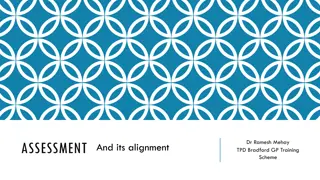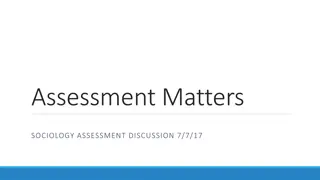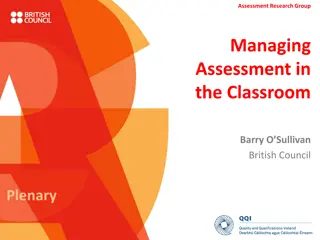Cultivating Assessment Proficiency in Social Work Education
Creating a culture of assessment in social work education is essential for continuous improvement. Curriculum at Barry University is designed to focus on advanced clinical social work practice within a trauma-informed resilience framework. The assessment plan includes multidimensional evaluation of competency through student learning outcomes and EPAS practice behaviors, utilizing embedded course assignments and field education assessments. Taskstream is used for tracking student competency with data collected year-round from various sources.
Download Presentation

Please find below an Image/Link to download the presentation.
The content on the website is provided AS IS for your information and personal use only. It may not be sold, licensed, or shared on other websites without obtaining consent from the author. Download presentation by click this link. If you encounter any issues during the download, it is possible that the publisher has removed the file from their server.
E N D
Presentation Transcript
Creating a Culture of Assessment Eva Nowakowski-sims, Phd, LCSW, MPH School of Social Work, Barry University
Assumptions that guide Assessment Proficiency is on based acquired knowledge and action together Curriculum is grounded in three sources: the Mission of the University, the Mission of the School, and the program goals of the BSW & MSW Programs The explicit (student competency) and implicit (educational environment) curriculum work collaboratively to create the BSW & MSW programs At Barry University, we have a single focus in Advanced Clinical Social Work Practice, within a trauma-informed resilience framework
Purpose: Continuous Improvement The assessment plan for the explicit curriculum focuses on the multidimensional assessment of competency through student learning outcomes/EPAS practice behaviors Assess the 2008/2015 EPAS practice behavior(s)using two different methods: embedded course assignment measures and the assessment of student competency in field education The program uses Taskstream, an online assessment program, for tracking student competency. Data collected year-round from faculty, field department, students BSW & Foundation year practice behaviors, Specialization year practice behaviors
Explicit Curriculum Embedded Course assignment Certain course assignments are designed to capture learning outcomes/EPAS practice behaviors EPAS Practice Behavior Course Practice Behavior Level of Competency Demonstrate Ethical and Professional Behavior Distinction between personal and professional values SW 503 Introduction to SW Profession Values Conflict paper Cognitive: knowledge Holistic: Values self-reflection Advanced Competence (4) Competent (3) Developing Competence (2) No competence (1) Student recognizes and manages personal values in a way that allows professional values to guide social work practice Student minimally recognizes and manages personal values in a way that allows professional values to guide social work practice Student fails to recognize and manage personal values in a way that allows professional values to guide social work practice Student comprehensively recognizes and manages personal values in a way that allows professional values to guide social work practice
Explicit Curriculum Assessment of Student Competency in Field Education Behavioral level of competency Students are assessed across all practice behaviors in SW 497 Field Education II, SW 577 Field Education II, & SW 689 Field Education IV. Assessment rubric: Advanced Competence (4), Competence (3), Developing Competence (2), No Competence (1). Field Educators complete the assessment in Taskstream
Benchmark 90% of students will attain a mean score of 3.0 or higher on a 4.0 Likert Scale on each of the 9 competencies Measured by both the embedded course assignments within each competency and corresponding Field Assessment (SW 497 for BSW, SW 577 for Foundation year, SW 689 for concentration year.) Total Competency benchmark is the mean score of the Embedded Measures and Field Assessment scores. Benchmark scores are updated yearly on the School website
Implicit Curriculum Formative assessment tools used to monitor achievement of outcomes Course evaluations Academic Advising Field Education experience Professional development Student open forums Results are shared with faculty, Dean & Associate Dean for review and discussion regarding improvement
Assessment: Evaluation The Assessment Coordinator prepares a yearly report of Assessment findings and presents the report to the Curriculum Committee at the first fall scheduled meeting. Committee reviews and discusses the Assessment findings. If improvements are needed, recommendations are made Committee Chair presents findings and recommendations to faculty Faculty discuss and vote to establishing a timeframe for further review and analysis
Creating a Culture of Assessment A clear communication on the importance of assessment Personnel dedicated to assessment and its findings Support from leadership An engaged faculty (most important and most difficult to achieve) WHY? Often times faculty are overburdened with the work of the program and may feel that assessment pulls them away from the art of teaching When there is a lack of understanding of the value and importance of assessment, it will be very difficult for faculty to be excited about doing extra work for assessment. The more knowledge you offer, the more excitement and less resistance you ll see in your faculty.
Faculty Engagement Problem: Faculty fear assessment, in that someone is evaluating their quality of teaching Solution: Faculty have a clear understanding that assessment is about student learning and be reassured that they can retain their style, their creativity, and grade their students without fear of punishment Problem: Faculty feel this is one more thing administration is asking of them Solution: Get faculty involved by hosting assessment forums and let them know how valuable and critical their input is to the future of student learning Problem: Getting faculty to complete the assessment rubrics. Solution: come together to realize we are all on the same team when it comes to student learning and much of the required assessment is already being collected by faculty; offer ongoing support
Communication is Key! By educating our faculty on the importance of being able to demonstrate learning through data, removing any punitive connotations, and involving them in the creation and maintenance of assessment plan, you can build a culture of assessment in your program.























